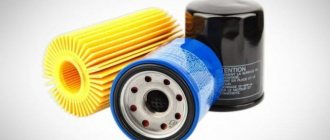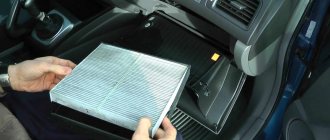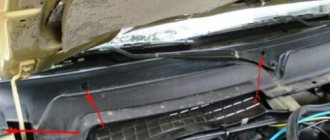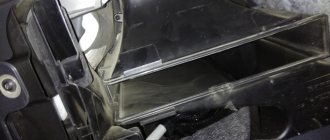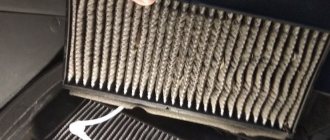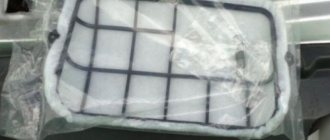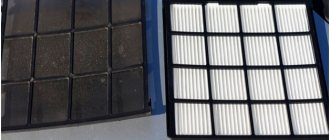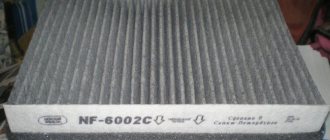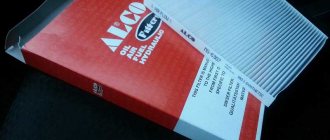Cabin filters have appeared on the shelves of auto stores quite recently. That is why today not all car owners understand how important this element is in creating a comfortable air environment in the cabin, and how it ensures their personal safety. This happens due to the fact that most motorists do not have a clear understanding of the operating principle of the cabin filter. Very often, drivers consider such a device unnecessary in a car and treat it appropriately: they save on buying and replacing it, and try to wash or clean the old one instead of purchasing a new filter.
Meanwhile, cabin filters are extremely important and their presence should be considered not as a luxury item, but as a required safety feature. In this regard, developers are constantly improving these cleaning elements, and if previously there was only one type of filter on sale - a regular, dust filter, now its carbon “colleague” has also appeared.
Many car owners wonder which filter is best to install in their car, what are the pros and cons of each type? In this article we will try to answer this question, as well as reveal the principles of operation of both types of filters.
Design and purpose of an anti-dust (conventional) filter
The anti-dust or anti-allergen filter is a white rectangle made of synthetic or cellulose fiber with corrugated paper laid in rows. The density of the filter material is lower than that of the paper element in the air filter - the vacuum in the ventilation system is much lower than that formed in the intake manifold during suction. The dust filter, in addition to dust, has the ability to retain other particles of contaminants, such as soot, rubber, pollen and heavy chemical compounds. If the filter fibers have been chlorinated, it will have the ability to neutralize certain types of dangerous bacteria. If the filter uses synthetic fiber, then, among other functions, it can attract small particles through electrical voltage.
Advantages:
- Possibility of using the fan, even when driving in a tunnel or standing in a traffic jam;
- Reduced “sweating” of glass;
- Filtration of large and small debris;
- Filtration of pollen, spores and bacteria.
- Low cost.
Flaws:
- Does not retain hazardous toxic substances.
- Does not cope with foreign odors.
Leading manufacturers
Yes, if you want to be absolutely sure of the quality of a consumable, its origin and efficiency, then it makes sense to spend money on an original spare part by contacting an official dealer or the official service center of the automaker.
In other cases, by giving preference to analogues and turning to trusted sellers, saving on consumables will definitely not be detrimental.
Here you just need to determine which manufacturer of cabin filters to give preference to.
Consumers are making increasingly high demands, they are beginning to understand much better the efficiency of interior repairs and are able to distinguish high-quality spare parts from downright bad ones. Therefore, companies that produce low-quality samples of cabin filters are not in demand.
This also allows us to highlight some favorites that are trustworthy and whose products there is no doubt about. You always need to make allowances for the likelihood of buying a fake, but here each motorist decides for himself where and from whom to buy consumables.
Among the most reputable and well-established manufacturers of cabin filters, it is worth highlighting the following:
- Bosch. One of the most famous manufacturers of auto parts. Moreover, a wide range of products does not negatively affect the final quality. They have excellent characteristics, average throughput coefficient. Bosch produces interior fittings for almost all modern cars. The average price is about 500-600 rubles, which puts Bosch in the premium category.
- Corteco. Another excellent brand that came to the Russian market from Germany. Offers a range of dust and carbon filters for a wide range of machines. Also a premium category, and the average price tag will be 600 rubles.
- Mann Filter. Some of their filters cost the same as original parts. But this can be justified by the highest quality. One of the most popular filters in the premium category.
- Knecht Mahle. Although their headquarters is in Germany, production is concentrated throughout Europe and beyond. But every company produces filters of the same high quality. There are no complaints.
- Raf Filter. Joint production of Russian and Chinese companies. They produce quite expensive consumables that are in deserved demand. They are well adapted to Russian operating conditions and have a long service life.
- AMD. A worthy option among budget filters, which can be purchased for 200-250 rubles even for an expensive foreign car. At the same time, they cope with the task perfectly. Not a bad option to save money, but not at the expense of quality.
- Denso. A Japanese brand that has gained immense popularity all over the world. Prices for some consumables exceed 1 thousand rubles. But at the same time, the original will cost 2-3 thousand rubles, so here we are talking about savings when servicing expensive cars.
- Fram. A Slovenian company that produces mid-price salons. They combine high quality, long service life and reasonable price.
- Filtron. Among the budget category of filters, these are some of the best, if not the best. They are extremely popular in Russia and the CIS countries. The manufacturer itself is from Poland. Offers a huge range for almost any car. It won’t be difficult to find consumables for a car that has not been produced for more than 5-10 years.
- Goodwill. Chinese brand of European quality level. The average price tag is 250-300 rubles. A large selection, good quality, and a high level of efficiency make the company a market leader.
- Big Filter. Another representative of the middle and even rather budget price range. Fully worth the money, but not inferior to the originals, which cost 2-3 times more.
Big Filter paper filter
When purchasing a car interior by manufacturer, it is important to make allowances for a specific car. All leading manufacturers are trying to produce products at the level of the machine itself. Therefore, no one is interested in producing a high-quality and expensive filter with a market value of about 800-1500 rubles for cars that belong to the budget segment. No one will buy a filtration element for Renault Logan for that kind of money. Because of this, the vast majority of analogues for such a machine cost 100-500 rubles, but no more.
The more expensive the car, the higher the cost of the original filter will be. But a high-quality analogue for such a machine cannot cost 100-300 rubles. And this is important to understand.
Basically, consumers are guided by their own preferences and are guided by the cost of the car itself. Plus, we must not forget about the financial condition of each individual car owner. Some, even with a great desire, cannot afford to buy a filter for 1000 rubles. Moreover, when it is possible to buy an incomparable analogue for 200-300 rubles. This is considered a rational use of funds for car maintenance.
Design and purpose of a carbon filter
Carbon filters are an improved continuation of dust filters. They have a multi-layer design, which consists of layers of fiber and activated carbon. The first layer is a coarse filtrate, which retains large-sized debris contained in the air. The second layer is made of microfiber, which absorbs small particles that can enter the lungs. The third layer, separated from the first two, is a layer of molded activated carbon, famous for its absorbent properties. It removes unpleasant odors and dangerous volatile compounds - sulfur oxides, nitrogen oxides and substances of benzene, phenolic and other groups. Most of these compounds cause irreparable harm to human health, being carcinogens. When they are combined with coal, absorption or absorption of harmful substances occurs with partial neutralization.
Advantages:
- Possibility of using a blower fan, even when driving in a tunnel or traffic jam;
- Reduced “sweating” of glass;
- Filtration of all harmful substances by 95%;
- Ozone, harmful to humans, is converted into oxygen;
- Activated carbon removes unpleasant odors and harmful volatile compounds.
Flaws:
- High price
No less worthy brands
Which cabin filter is better - carbon or regular? Regarding manufacturers, you can pay attention to other equally well-known brands. Some premium cars come off the assembly line already equipped with filters
For example, Eiken products are often installed on Japanese-made vehicle models.
The list of manufacturers with expensive, but at the same time high-quality cabin filters includes Valeo. Their coal-type products are expensive, but since the company maintains its brand and values its reputation, you don’t have to worry about the quality. After installing these filters, you can rid yourself of unpleasant odors once and for all.
So which filter is better?
Not so long ago, carbon versions appeared in the assortment of cabin filter manufacturers at a price 1.5-2 times higher than their anti-dust counterparts. A completely logical question arises: how justified is the installation of a carbon filter?
As we can see from a comparison of the advantages and disadvantages of both types of cabin filters, carbon is superior to anti-dust filters in several respects. But, let’s figure it out, maybe these parameters are not so significant and it’s better to buy a regular filter than to overpay for a carbon one?
First of all, you need to identify the tasks that the cabin filter should perform. It must capture all types of contaminants - dust, small insects, etc., to ensure a comfortable ride not only for the driver, but also for the passenger. And if ideally, then it will retain chemical compounds dissolved in the air, as well as harmful microorganisms. The bottom line is that large gaseous compounds based on hydrocarbons, such as methanol, ethylene and more complex organic substances, are concentrated in large cities and highways.
Unfortunately, the cabin dust filter does not trap these gases, unlike a carbon one. The layer with activated carbon has a great ability to retain and absorb impurities of various kinds. That is, it captures not only large particles of pollution, but also heavy compounds that are in a gaseous state.
Based on the clinical studies conducted, we can say with complete confidence that some organic compounds present in car exhaust gases and urban smog have a detrimental effect not only on the general state of health, but also on the perception of it. An insufficient amount of oxygen leads to slower reactions, increased irritability, nausea, and even disorders in the human nervous system. Naturally, every such trip becomes dangerous. And only a carbon filter can help cope with this problem. If the mass of activated carbon and its placement meet current standards, then such a cabin filter can reduce the content of harmful impurities in the air by 2.5-3.5 times.
Special mention should be made about chemical compounds such as nitrogen dioxide and nitric oxide. Carbon filters are most active in relation to these elements and are capable of reducing their content in the cabin by tens of times. This makes carbon filters even more necessary, as nitrogen oxides have a detrimental effect on mucous membranes, burning eyes and drying out the nasopharynx and mouth. Such exposure not only causes discomfort, but also harms health and provokes emergency situations.
Test results
In terms of efficiency, the LX 2010 filter element (Mahle) showed the best results. This can be explained by the high filtering properties of the material used in its manufacture. And in combination with other parameters, this filter can be considered the best in the entire group of tested samples.
In second place, but only in terms of filtration efficiency, is Fram. Despite the difference of only 0.01%, this example is very far from the first. It showed the lowest dust capacity (107.6 grams). This can be explained by using a material that is too dense for a curtain of this size. With such a high initial resistance as this sample, the result could not have been different.
The Sakura filter showed good efficiency - at the level of 99.2%. But, as can be seen from the dust holding capacity (111 grams), this parameter was achieved due to a significant reduction in the efficiency of the resource. Perhaps, in this case, this result was obtained not due to the parameters of the curtain material, but due to the low filtration area. For this sample it is minimal.
Next in efficiency is BIG Filter with a value of 99.18%. It fell behind third place by 0.02%, but with a mass of accumulated dust of 181.5 grams. In general, a decent result in terms of all parameters.
In fifth place is Bosch with an efficiency of 99.12% and a dust capacity of 135 grams. Such mediocre results can be explained by the poor design of the filter curtain. This sample has the maximum filtration area of all presented. It was achieved due to a large number of corrugations, which during installation leads to a significant compaction of the “pockets” and, as a consequence, high initial resistance and reduced service life.
Filtron result is 99.11%. But its dust capacity is much higher - 144.3 grams. The low dust capacity compared to previous samples can be explained by the small filtration area of the curtain and the material with average parameters.
In seventh place is Champion with an efficiency value of 98.61. This value is on the verge of the permissible value of the final efficiency of a car filter (99%). This result, taking into account the dust holding capacity of 191.1 grams, can be explained by the use of mediocre material for making the curtains - the pores in the paper are too large for this size and design.
The lowest efficiency, to our great surprise, was shown by Mann-Filter - 96.73%. It is difficult to say what caused such poor results from such a well-known brand. In all other respects, the sample looks quite decent. Its dust capacity is simply deafening - 234.6 grams! It is possible that there was a defect in the sample that was not detected during an external examination, so a detailed study is necessary to establish all the reasons. But it is preferable to test a new sample, or even better, three samples, and then draw a conclusion about this model.
Carbon filter service life
To summarize, we can now say without a doubt that a carbon filter is much better than a dust filter. And if our conclusions have convinced you, then most likely you will ask the question - what is the service life of the cabin filter? There are two criteria here that need to be taken into account. The carbon filter supports two functions at once - absorbs dust and volatile gases. If it is used in the summer, the car is driven on dirt roads, then the service life will be approximately the same as that of the air filter. If the car owner rarely drives his car or uses it in urban conditions, then the service life of the filter increases - the activated carbon is depleted in about 3-4 months, and the filter element itself can perform its functions for a long time.
At this moment we can absolutely say that in the current environmental situation, the cabin filter has become an integral part of the car.
We present you the following video that will help you replace the cabin filter yourself:
Cabin filters have appeared on the shelves of auto stores quite recently. That is why today not all car owners understand how important this element is in creating a comfortable air environment in the cabin, and how it ensures their personal safety. This happens due to the fact that most motorists do not have a clear understanding of the operating principle of the cabin filter. Very often, drivers consider such a device unnecessary in a car and treat it appropriately: they save on buying and replacing it, and try to wash or clean the old one instead of purchasing a new filter.
Meanwhile, cabin filters are extremely important and their presence should be considered not as a luxury item, but as a required safety feature. In this regard, developers are constantly improving these cleaning elements, and if previously there was only one type of filter on sale - a regular, dust filter, now its carbon “colleague” has also appeared.
Many car owners wonder which filter is best to install in their car, what are the pros and cons of each type? In this article we will try to answer this question, as well as reveal the principles of operation of both types of filters.
Test method
The air filter test bench is built according to the ISO 5011 standard used to test these components - and uses all testing methods.
The filter being tested is installed in its original housing (ideal for testing). Next, using a fan, the injection of rarefied air is simulated, as during normal movement. The air flow should be what the engine uses at rated power.
First parameter
— initial resistance. (auxiliary, directly involved in determining dust capacity) It demonstrates what resistance the filter has to air flow, how “easy it is to breathe” for an engine equipped with such a filter. Its value directly determines the life of the filter element. The higher this value, the lower the resource. The initial resistance depends solely on the design of the engine air path, the size of the window covered by the filter element, the material used to make the curtain, and its parameters (the size of the corrugations and their number). Since the comparative tests used the same housing, adapters and feeder, the factors determining the initial resistance were the curtain material, the dimensions of the corrugations and the quality of workmanship.
Second parameter
- dust capacity. This is, in fact, a resource as such. This parameter has no lower limit. In principle, there is no upper one either, but the higher this indicator, the better. The car manufacturer regulates it with the requirement “not less than...”. The key factor determining this parameter is the filtering surface area of the curtain. As an integral indicator, it evaluates its shape, geometry and dimensions. The second most important factor is the properties of the curtain material (air permeability, average and maximum pore size). The division into “first” and “second” factors is very arbitrary in importance, since they largely influence one another. Geometry is determined earlier during design purely chronologically, which is why in this description this factor is declared first.
Third parameter
— filtration efficiency. It shows how much dust supplied to the input was retained by the filter. The higher this parameter, the better. In terms of significance, it is more important than the previous two; when comparing filter elements, it is rated first, and only with equal efficiency values can these elements be compared in other parameters.
Design and purpose of an anti-dust (conventional) filter
The anti-dust or anti-allergen filter is a white rectangle made of synthetic or cellulose fiber with corrugated paper laid in rows. The density of the filter material is lower than that of the paper element in the air filter - the vacuum in the ventilation system is much lower than what is formed in the intake manifold during suction. The dust filter, in addition to dust, has the ability to retain other particles of contaminants, such as soot, rubber, pollen and heavy chemical compounds. If the filter fibers have been chlorinated, it will have the ability to neutralize certain types of dangerous bacteria. If the filter uses synthetic fiber, then, among other functions, it can attract small particles through electrical voltage.
Advantages:
- Possibility of using the fan, even when driving in a tunnel or standing in a traffic jam;
- Reduced “sweating” of glass;
- Filtration of large and small debris;
- Filtration of pollen, spores and bacteria.
- Low cost.
Flaws:
- Does not retain hazardous toxic substances.
- Does not cope with foreign odors.
Design and purpose of a carbon filter
Carbon filters are an improved continuation of dust filters. They have a multi-layer design, which consists of layers of fiber and activated carbon. The first layer is a coarse filtrate, which retains large-sized debris contained in the air. The second layer is made of microfiber, which absorbs small particles that can enter the lungs. The third layer, separated from the first two, is a layer of molded activated carbon, famous for its absorbent properties. It removes unpleasant odors and dangerous volatile compounds - sulfur oxides, nitrogen oxides and substances of benzene, phenolic and other groups. Most of these compounds cause irreparable harm to human health, being carcinogens. When they are combined with coal, absorption or absorption of harmful substances occurs with partial neutralization.
Advantages:
- Possibility of using a blower fan, even when driving in a tunnel or traffic jam;
- Reduced “sweating” of glass;
- Filtration of all harmful substances by 95%;
- Ozone, harmful to humans, is converted into oxygen;
- Activated carbon removes unpleasant odors and harmful volatile compounds.
Flaws:
- High price
So which filter is better?
Not so long ago, carbon versions appeared in the assortment of cabin filter manufacturers at a price 1.5-2 times higher than their anti-dust counterparts. A completely logical question arises: how justified is the installation of a carbon filter?
As we can see from a comparison of the advantages and disadvantages of both types of cabin filters, carbon is superior to anti-dust filters in several respects. But, let’s figure it out, maybe these parameters are not so significant and it’s better to purchase a regular filter than to overpay for a carbon one?
First of all, you need to identify the tasks that the cabin filter should perform. It must capture all types of contaminants - dust, small insects, etc., to ensure a comfortable ride not only for the driver, but also for the passenger. And if ideally, then it will retain chemical compounds dissolved in the air, as well as harmful microorganisms. The bottom line is that large gaseous compounds based on hydrocarbons, such as methanol, ethylene and more complex organic substances, are concentrated in large cities and highways.
Unfortunately, the cabin dust filter does not trap these gases, unlike a carbon one. The layer with activated carbon has a great ability to retain and absorb impurities of various kinds. That is, it captures not only large particles of pollution, but also heavy compounds that are in a gaseous state.
Based on the clinical studies conducted, we can say with complete confidence that some organic compounds present in car exhaust gases and urban smog have a detrimental effect not only on the general state of health, but also on the perception of it. An insufficient amount of oxygen leads to slower reactions, increased irritability, nausea, and even disorders in the human nervous system. Naturally, every such trip becomes dangerous. And only a carbon filter can help cope with this problem. If the mass of activated carbon and its placement meet current standards, then such a cabin filter can reduce the content of harmful impurities in the air by 2.5-3.5 times.
Special mention should be made about chemical compounds such as nitrogen dioxide and nitric oxide. Carbon filters are most active in relation to these elements and are capable of reducing their content in the cabin by tens of times. This makes carbon filters even more necessary, as nitrogen oxides have a detrimental effect on mucous membranes, burning eyes and drying out the nasopharynx and mouth. Such exposure not only causes discomfort, but also harms health and provokes emergency situations.
Net in the trunk of a car: creating order with your own hands
There are a number of motorists who install coal consumables for the winter and summer, not considering the costs for them unjustified. Others, in order to save money, prefer to use regular dust bags.
Yes, in terms of price, standard filters are superior. They are simple to implement, which is why production costs are minimal. But there are many conventional dust filters, the price of which is comparable to carbon ones. This is due to the well-known brand, as well as the use of high quality materials.
Classic salon shops can cost 100-200 rubles, or they can cost the buyer several thousand per unit of goods.
The most expensive filters, as practice shows, are original ones. But it doesn’t always make sense to overpay for them. There are a number of cheaper analogues that are in no way inferior in terms of quality.
Adding to the cost of carbon filters is their three-layer nature and a more complex manufacturing process.
Carbon filter service life
To summarize, we can now say without a doubt that a carbon filter is much better than a dust filter. And if our conclusions have convinced you, then most likely you will ask the question - what is the service life of the cabin filter? There are two criteria here that need to be taken into account. The carbon filter supports two functions at once - absorbs dust and volatile gases. If it is used in the summer, the car is driven on dirt roads, then the service life will be approximately the same as that of the air filter. If the car owner rarely drives his car or uses it in urban conditions, then the service life of the filter increases - the activated carbon is depleted in about 3-4 months, and the filter element itself can perform its functions for a long time.
At this moment we can absolutely say that in the current environmental situation, the cabin filter has become an integral part of the car.
We present you the following video that will help you replace the cabin filter yourself:
Consumable location
Automotive designers often think through everything down to the smallest detail. Since the cabin filter or cabin filter belongs to the category of frequently changed consumables, it makes no sense to hide it somewhere far away. It is important to ensure that access to it is as simple and quick as possible.
Alas, this does not always happen. And as a result, a simple replacement procedure turns into a real test with the need for complex dismantling work, as well as subsequent reassembly.
There are several standard places where cabin filters are most often installed:
- The most common space is behind the glove compartment. In some cases, the glove compartment must be completely removed. In other situations, only the box lid opens, and behind it there is already a filter housing. As simple and easy as possible. Every beginner can handle the replacement.
- Under the glove compartment at the front passenger's feet. The place is no longer so convenient, but it depends on the design features of a particular car. Sometimes it’s enough to bend down, snap off the cover of the filter housing, and the consumable is in your hands. In other situations, additional dismantling work is required to remove the side panel.
- Under the windshield, in the frill area. In the past, this location was often used to house the cabin filter. But the case (cassette) quickly became clogged with large debris. Recently, it is becoming increasingly rare to see a filter under the windshield on the driver’s side.
- At the driver's feet. The worst place for a salon. But some people stubbornly continue to install the filter housing there. In the best case, you just have to remove the side panel of the center console. In the worst case, changing the element requires dismantling the pedal assembly.
In extremely rare situations, you can find some alternative layout options. Mostly, salonniks always stand at one of the listed points.
If you just bought a car, went through all the potential places, but found nothing, there is a chance that your car does not have a filter at all. We recommend that you also take a look at the instruction manual to make sure of this.
Clean and dirty Corteco consumables
